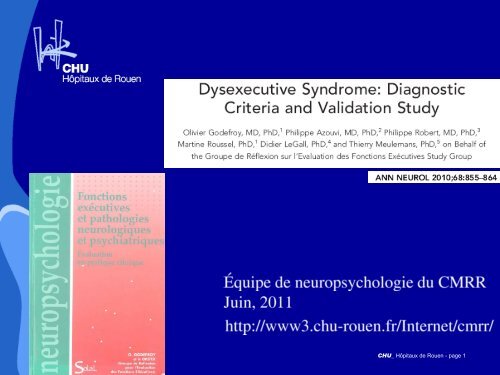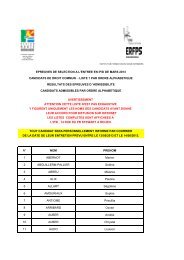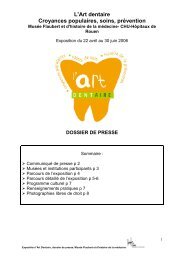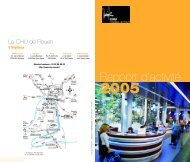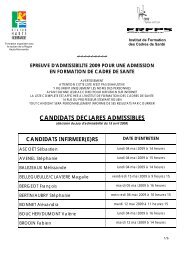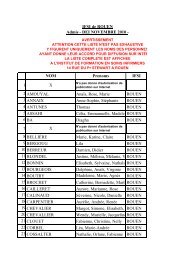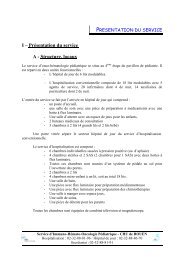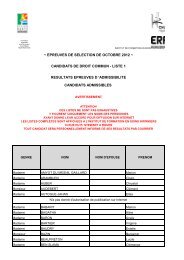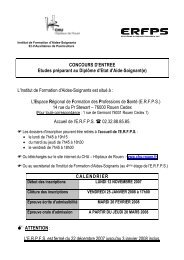6 - CHU de Rouen
6 - CHU de Rouen
6 - CHU de Rouen
You also want an ePaper? Increase the reach of your titles
YUMPU automatically turns print PDFs into web optimized ePapers that Google loves.
<strong>CHU</strong>_ Hôpitaux <strong>de</strong> <strong>Rouen</strong> - page 1
Fonctions exécutivesFonctions <strong>de</strong> contrôle <strong>de</strong> haut niveauDésignent (Lezak, 1982) :l’établissement d’objectifl’initiationl’inhibitionla planificationla flexibilité mentalela vérificationEnglobent (Go<strong>de</strong>froy, 2010) :cognition socialethéorie <strong>de</strong> l’espritprocessus stratégique <strong>de</strong> récupération en mémoire épisodique<strong>CHU</strong>_Hôpitaux <strong>de</strong> <strong>Rouen</strong> - page 2
Les troubles exécutifs concernent diverses pathologies :DFTMAPathologies vasculaires,Psychiatriques…Signes cliniques distinguant (Go<strong>de</strong>froy et al., 2004 ) :syndrome dyséxecutif cognitifsyndrome dyséxecutif comportemental<strong>CHU</strong>_Hôpitaux <strong>de</strong> <strong>Rouen</strong> - page 4
Troubles comportementaux et cognitifsspécifiquesTroublescomportementaux :Troubles cognitifs :Hypoactivité globaleHyperactivité globaleStéréotypies etpersévérationsDépendanceenvironnementaleInhibition <strong>de</strong> réponse etattention focaliséeDéduction et génération <strong>de</strong>règlesMaintien et flexibilitémentaleInitiation verbale<strong>CHU</strong>_Hôpitaux <strong>de</strong> <strong>Rouen</strong> - page 5
Troubles comportementaux et cognitifsen faveur ou à l’étu<strong>de</strong>Troublescomportementaux :Troubles cognitifs :ConfabulationsAnosognosie etanosodiaphorieTroubles émotionnels et ducomportement socialTroubles du comportementalimentaire, sexuel etsphinctérienProcessus mnésiquesstratégiquesPlanification et résolution<strong>de</strong> problèmesCoordination <strong>de</strong> tachesdoubles, attention soutenueet initiation <strong>de</strong> l’actionThéorie <strong>de</strong> l’esprit<strong>CHU</strong>_Hôpitaux <strong>de</strong> <strong>Rouen</strong> - page 6
Batterie GREFEXIncluant (Go<strong>de</strong>froy et al., 2008 ) :7 épreuves cognitives1 questionnaire comportementalÉpreuves sélectionnées :publications ayant démontrées leur intérêtsondage multicentrique sur les pratiques cliniques<strong>CHU</strong>_Hôpitaux <strong>de</strong> <strong>Rouen</strong> - page 7
Population718 sujets3 classes d’âge : 60 ans3 niveaux <strong>de</strong> scolarité :< CEP, < Bac, > Bac<strong>CHU</strong>_Hôpitaux <strong>de</strong> <strong>Rouen</strong> - page 8
Batterie GREFEX :évaluation cognitive<strong>CHU</strong>_ Hôpitaux <strong>de</strong> <strong>Rouen</strong> - page 9
Épreuves cognitivesFluences verbalesTest <strong>de</strong> StroopTrail Making TestModified Card Sorting TestDouble tâche <strong>de</strong> Bad<strong>de</strong>leyTest <strong>de</strong> BrixtonTest modifié <strong>de</strong>s six éléments<strong>CHU</strong>_Hôpitaux <strong>de</strong> <strong>Rouen</strong> - page 10
Évocation lexicaleformelle : lettre « P »Fluences verbalesÉvocation lexicalesémantique : animauxPour chaque fluence :Nombre <strong>de</strong> mots(n = 2 indices)<strong>CHU</strong>_Hôpitaux <strong>de</strong> <strong>Rouen</strong> - page 11
Test <strong>de</strong> StroopPour chaque condition :Temps <strong>de</strong> réalisationNombre d’erreurs(n = 6 indices)<strong>CHU</strong>_Hôpitaux <strong>de</strong> <strong>Rouen</strong> - page 12
Trail-Making TestPartie A :Temps <strong>de</strong> réalisationNombre d’erreursPartie B :Temps <strong>de</strong> réalisationNombre d’erreursNombre <strong>de</strong> persévérations(n = 5 indices)<strong>CHU</strong>_Hôpitaux <strong>de</strong> <strong>Rouen</strong> - page 13
Modified Card Sorting TestNombre <strong>de</strong> catégoriesNombre d’erreursNombre <strong>de</strong> persévérations(n = 3 indices)<strong>CHU</strong>_Hôpitaux <strong>de</strong> <strong>Rouen</strong> - page 14
Double tâche <strong>de</strong> Bad<strong>de</strong>leyMu ( )(n = 1 indice)<strong>CHU</strong>_Hôpitaux <strong>de</strong> <strong>Rouen</strong> - page 15
Test <strong>de</strong> BrixtonNombre d’erreurs(n = 1 indice)<strong>CHU</strong>_Hôpitaux <strong>de</strong> <strong>Rouen</strong> - page 16
Nombre d’erreurs12 3 45(n = 1 indice)6 7 8 9 10<strong>CHU</strong>_Hôpitaux <strong>de</strong> <strong>Rouen</strong> - page 17
Nombre d’erreurs12 3 45(n = 1 indice)6 7 8 9 10<strong>CHU</strong>_Hôpitaux <strong>de</strong> <strong>Rouen</strong> - page 18
Nombre d’erreurs12 3 45(n = 1 indice)6 7 8 9 10<strong>CHU</strong>_Hôpitaux <strong>de</strong> <strong>Rouen</strong> - page 19
Nombre d’erreurs12 3 45(n = 1 indice)6 7 8 9 10<strong>CHU</strong>_Hôpitaux <strong>de</strong> <strong>Rouen</strong> - page 20
Test modifié <strong>de</strong>s six élémentsRang(n = 1 indice)<strong>CHU</strong>_Hôpitaux <strong>de</strong> <strong>Rouen</strong> - page 21
Batterie GREFEX : évaluation cognitiveGénération d’informationsInitiation d’actionInhibitionFlexibilité mentaleDéduction <strong>de</strong> règlesCoordinationPlanificationFluences verbalesTemps dénomination, lecture Stroop,TMT AInterférence StroopPersévérations TMT B, MCST, BrixtonCatégories MCST, BrixtonDouble tâche6 éléments<strong>CHU</strong>_Hôpitaux <strong>de</strong> <strong>Rouen</strong> - page 22
Batterie GREFEX : évaluation cognitiveFluences verbales (n = 2 indices)Test <strong>de</strong> Stroop (n = 6 indices)Trail Making Test (n = 5 indices)Modified Card Sorting Test (n = 3 indices)Double tâche <strong>de</strong> Bad<strong>de</strong>ley (n = 1 indice)Test <strong>de</strong> Brixton (n = 1 indice)Test modifié <strong>de</strong>s six éléments (n = 1 indice)19 indices au total pour 7 épreuvesSi > 3 indices déficitaires : syndrome dysexécutifcognitifSensibilité : 0.42 ; Spécificité : 0.94<strong>CHU</strong>_Hôpitaux <strong>de</strong> <strong>Rouen</strong> - page 23
68 ansCAP-ven<strong>de</strong>useExemple 1: Mme D.Trouble moteur évoluant <strong>de</strong>puis 2 ans, chutesPas d’amélioration sous dopathérapieAspontanéité ++Suspicion <strong>de</strong> paralysie supra-nucléaire progressive<strong>CHU</strong>_Hôpitaux <strong>de</strong> <strong>Rouen</strong> - page 24
Exemple 1 : Mme D.MAX SCOREGROBER & BUSCHKER. immédiat 16 11R. libre 1 16 4R. total 1 16 14R. libre 2 16 5MEMOIRE R. total 2 16 15R. libre 3 16 6R. total 3 16 16R. libre différé 16 7R. total différé 16 16Pathologique si < au percentile 5<strong>CHU</strong>_Hôpitaux <strong>de</strong> <strong>Rouen</strong> - page 25
Exemple 1 : Mme D.MAX SCOREFLUENCES ( 2min )FONCTIONS "p" 20EXECUTIVES "animaux" 15MCSTCatégorie 6 2Erreurs 0 36Persévérations 0 144 indices pathologiquesPathologique si < au percentile 5syndrome dysexécutif cognitif<strong>CHU</strong>_Hôpitaux <strong>de</strong> <strong>Rouen</strong> - page 26
Exemple 2 : Mme L.53 ans, Niveau DAcci<strong>de</strong>nt <strong>de</strong> la voie publiqueTC, scanner normalPlainte mnésique et attentionnelleDifficultés d’organisation et <strong>de</strong> planificationLégère altération thymique<strong>CHU</strong>_Hôpitaux <strong>de</strong> <strong>Rouen</strong> - page 27
Exemple 2 : Mme L.ECHELLE CLINIQUE DEMEMOIREMAXScoreMémoire verbale 140 95MEMOIRE Mémoire visuelle 140 108Mémoire générale 140 100Attention / concentration 140 101Rappel différé 140 102Pathologique si < au percentile 5<strong>CHU</strong>_Hôpitaux <strong>de</strong> <strong>Rouen</strong> - page 28
Exemple 2 : Mme L.FONCTIONSEXECUTIVESFLUENCES« p » 29« animaux » 23STROOP TESTTps dénomination60sTps lecture45sTps interférence120sErreurs interférence 0TRAIL MAKING TESTTemps A28sTemps B39sErreurs B 1Pathologique si < au percentile 5<strong>CHU</strong>_Hôpitaux <strong>de</strong> <strong>Rouen</strong> - page 29
Exemple 2 : Mme L.FONTIONSEXECUTIVESWISCONSINNombre <strong>de</strong> critères 6Nombre d'erreurs 1Nombre0d'erreurs persévérativesDOUBLE TACHE DEBADDELEYµ 89,5BRIXTONErreurs 13Pathologique si < au percentile 5<strong>CHU</strong>_Hôpitaux <strong>de</strong> <strong>Rouen</strong> - page 30
Exemple 2 : Mme L.1 indice pathologiqueabsence <strong>de</strong> syndrome dysexécutif cognitif<strong>CHU</strong>_Hôpitaux <strong>de</strong> <strong>Rouen</strong> - page 31
Batterie GREFEX :évaluation comportementale<strong>CHU</strong>_ Hôpitaux <strong>de</strong> <strong>Rouen</strong> - page 32
Inventaire du Syndrome DysexécutifComportemental (ISDC)Syndrome dysexécutif comportemental :Modifications comportementales par rapport aucomportement antérieur du sujetRetentissement au quotidienNe pouvant être expliqué par un déficit perceptif, moteur,aphasique, par un syndrome dépressif ou anxieux, par untraitement (notamment neuroleptique)<strong>CHU</strong>_Hôpitaux <strong>de</strong> <strong>Rouen</strong> - page 33
ISDC(Questionnaire rempli par l’accompagnant)12 axes comportementaux<strong>CHU</strong>_Hôpitaux <strong>de</strong> <strong>Rouen</strong> - page 34
Exemple : DésintérêtLe patient ressent-il moins fortement les émotions?Se désintéresse-t-il <strong>de</strong> ses activités? Est-il plus indifférente à sonentourage?Non: considérez cette sous-échelle comme inappropriée et passez à la suivanteOui (ou doute): posez les questions complémentaires ci-<strong>de</strong>ssous1- Le patient exprime-t-il moins fortement les émotions (joie, colère, tristesse)?oui non2- S’intéresse-t-il moins à ses activités habituelles? oui non3- A-t-il plus <strong>de</strong> difficultés à exprimer son affection? oui non4- S’intéresse-t-il moins aux activités et aux projets <strong>de</strong>s autres? oui non5- Le patient est-il plus indifférent à sa famille ou à ses amis? oui non6- A-t-il moins d’enthousiasme pour <strong>de</strong>s activités nouvelles? oui non7- Exprime-t-il moins <strong>de</strong> souhaits, <strong>de</strong> désirs? oui non8- Est-il indifférent à ses difficultés, à son avenir? oui non<strong>CHU</strong>_Hôpitaux <strong>de</strong> <strong>Rouen</strong> - page 35
Grille d’évaluationIntensité = Fréquence X Gravité Score /12Retentissement Score /5<strong>CHU</strong>_Hôpitaux <strong>de</strong> <strong>Rouen</strong> - page 36
ISDC3 axes déviantssyndrome dysexécutif comportemental significatifRéduction activité Anticipation Désinteret Euphorie Irritabilité HyperactivitéIntensité (/12) > 3 > 3 > 3 > 3 > 3 > 3Retentissement (/5) > 3 > 3 > 3 > 3 > 3 > 3PerséverationsDépendanceenvironnementaleAnosognosieConfabulationsTr. ConduitessocialesTr. ConduitessexuellesIntensité (/12) > 3 > 3 > 3 > 3 > 3 > 3Retentissement (/5) > 3 > 3 > 3 > 3 > 3 > 3<strong>CHU</strong>_Hôpitaux <strong>de</strong> <strong>Rouen</strong> - page 37
Exemple : Mme G.41 ansNiveau BEvaluation cognitive après rupture anévrysme ACoAPlainte mnésique +++Mémoire autobiographique préservéeAntécé<strong>de</strong>nts médicaux et chirurgicaux :MigrainesThyroï<strong>de</strong>ctomie, hystérectomieColopathie fonctionnelleTtt : Levothyrox, Un-alpha, Orocal, antalgiques ++<strong>CHU</strong>_Hôpitaux <strong>de</strong> <strong>Rouen</strong> - page 38
TOC avant l’opérationModifications comportementales <strong>de</strong>puis l’interventionAppétit : ok mais nausées fréquentesSommeil : difficultés endormissementanxiété : échelle <strong>de</strong> Goldberg = 9/9Thymie : MADRS = 36/60<strong>CHU</strong>_Hôpitaux <strong>de</strong> <strong>Rouen</strong> - page 39
IRM séquence T2<strong>CHU</strong>_Hôpitaux <strong>de</strong> <strong>Rouen</strong> - page 40
Bilan neuropsychologiqueNotesEPREUVES GLOBALES MMS 29PM 38 39MILL-HILL 55LANGAGE DO 80 80TOKEN TEST 36VISUO-CONSTRUCTION FIGURE DE REY 36Inférieur au percentile 5 ou à la valeur seuil<strong>CHU</strong>_Hôpitaux <strong>de</strong> <strong>Rouen</strong> - page 41
Bilan neuropsychologique : mémoireMEMOIRENotesGROBER ET BUSCHKER. Immédiat 16R. Libre 1 7R. Total 1 16R. Libre 2 10R. Total 2 16R. Libre 3 10R. Total 3 16Reconnaissance 16R. Libre Différé 12R. Total Différé 16TEST DES PORTESPartie A 11Partie B 6Inférieur au percentile 5 ou à la valeur seuil<strong>CHU</strong>_Hôpitaux <strong>de</strong> <strong>Rouen</strong> - page 42
Bilan neuropsychologique : FEFONCTIONS EXECUTIVESNotesTRAIL MAKING TESTTps A 39Erreurs A 0Tps B 77Erreurs B 0Persévérations 0WISCONSINNb catégories 6Nb erreurs 1Nb persévérations 0FLUENCES VERBALESLettre "P" 25Animaux 33Inférieur au percentile 5 ou à la valeur seuil<strong>CHU</strong>_Hôpitaux <strong>de</strong> <strong>Rouen</strong> - page 43
Conclusion bilan neuropsychologiqueAbsence <strong>de</strong> déficit cognitif objectivé par les testsmaisTrouble attentionnel<strong>CHU</strong>_Hôpitaux <strong>de</strong> <strong>Rouen</strong> - page 45
Évaluation comportementale : ISDCRéduction activité Anticipation Désinteret Euphorie Irritabilité HyperactivitéIntensité (/12) 8 6 2 2 6 9Retentissement (/5) 4 3 1 2 4 4PerséverationsDépendanceenvironnementaleAnosognosieConfabulationsTr. ConduitessocialesTr. ConduitessexuellesIntensité (/12) 2 2 1 0 0 0Retentissement (/5) 2 1 1 0 0 04 axes déviantsInférieur au percentile 5 ou à la valeur seuilsyndrome dysexécutif comportemental<strong>CHU</strong>_Hôpitaux <strong>de</strong> <strong>Rouen</strong> - page 46
ConclusionAbsence <strong>de</strong> syndrome dysexécutif cognitifmaisPrésence d’un syndrome dysexécutif comportemental<strong>CHU</strong>_Hôpitaux <strong>de</strong> <strong>Rouen</strong> - page 47
Résultats GREFEXComparaison patients/témoinsÉpreuves cognitives : 461 patients / 461 témoins appariésEntre 16 et 90 ansMMS > 16/30Pathologies <strong>de</strong>s patients :AVC (152)TC (112)MA (73)SEP (50)Maladie <strong>de</strong> Parkinson (45)MCI (18)Autres (11)Batterie complète (épreuves cognitives + ISDC) : 280 patients<strong>CHU</strong>_Hôpitaux <strong>de</strong> <strong>Rouen</strong> - page 48
Résultats GREFEXComparaison patients/témoinsSur 280 patients ayant eu la batterie GREFEX complète :59,6 % présentent un syndrome dysexécutif25.7% : syndrome dysexécutif cognitif et comportemental16.4 % : syndrome dysexécutif comportemental isolé17.5 % : syndrome dysexécutif cognitif isoléDouble dissociation fréquente entre syndrome dysexécutifcognitif et comportemental<strong>CHU</strong>_Hôpitaux <strong>de</strong> <strong>Rouen</strong> - page 49
Syndrome dysexécutif comportementalPrésent chez :65 % <strong>de</strong>s patients MA57 % <strong>de</strong>s patients TC42 % <strong>de</strong>s patients Parkinson38 % <strong>de</strong>s patients SEP25 % <strong>de</strong>s patients AVCPattern semblable pour les différentes pathologies :AnosognosieRéduction <strong>de</strong>s activités<strong>CHU</strong>_Hôpitaux <strong>de</strong> <strong>Rouen</strong> - page 50
Présent chez :Syndrome dysexécutif cognitif73 % <strong>de</strong>s patients MA54 % <strong>de</strong>s patients TC39 % <strong>de</strong>s patients Parkinson29 % <strong>de</strong>s patients AVC28 % <strong>de</strong>s patients SEPVariabilité <strong>de</strong>s troubles suivant la pathologie :Génération d’information : MAPlanification : MAFlexibilité mentale : MA et ParkinsonInitiation <strong>de</strong> l’action : TC et SEPDéduction : AVC et TC<strong>CHU</strong>_Hôpitaux <strong>de</strong> <strong>Rouen</strong> - page 51
ConclusionSyndrome dysexécutif cognitif :> 3 scores pathologiquesSyndrome dysexécutif comportemental :> 3 axes déviantsDouble dissociation fréquente<strong>CHU</strong>_Hôpitaux <strong>de</strong> <strong>Rouen</strong> - page 52


